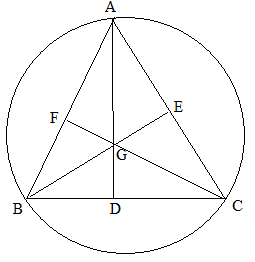
In an equilateral triangle prove that the centroid and centre of the circumcircle coincide.
Answer
583.2k+ views
Hint: In this question, first of all we will draw an equilateral triangle inscribed in a circle and also draw the three medians of the triangle. To show that G is the centre of the circumcircle, we will show that G is equidistant from A, B and C.
Complete step by step solution:
Let us first make diagram:

Construction: We have drawn median AD, BE and CF.
Let G be the centroid of triangle ABC.
Triangle ABC is an equilateral triangle.
$\therefore $ AB = BC = CA. And $\angle ABC = \angle BAC = \angle BCA = {60^0}$
And we can also say that $\dfrac{{AB}}{2} = \dfrac{{BC}}{2} = \dfrac{{CA}}{2}$ $ \Rightarrow $ BF =AF= BD = EC=AE.
Now, in $\vartriangle BFC$and$\vartriangle BEC$, we have:
BC= BC (Common Side)
$\angle FBC = \angle ECB = {60^0}$
BF = EC.
So, by SAS rule of congruence, we can write:
$\vartriangle BFC$ $ \cong $$\vartriangle BEC$.
$\because $ The two triangles are congruent. So, all angles and sides of one triangle are equal to corresponding angles and sides of another triangle.
Therefore , we have BE= CF. (1)
Now, in $\vartriangle ABE$and$\vartriangle ABD$, we have:
AB= AB (Common Side)
$\angle BAE = \angle ABD = {60^0}$
BD = AE.
So, by SAS rule of congruence, we can write:
$\vartriangle ABE$$ \cong $$\vartriangle ABD$
$\because $ The two triangles are congruent. So, all angles and sides of one triangle are equal to corresponding angles and sides of another triangle.
Therefore , we have BE= AD. (2)
From equation 1 and 2, we get:
AD = BE = CF. (3)
Now , we know that the G( the centroid) of the triangle divides the median in a 2:3 ratio.
So, on dividing the equation 4 by 2/3, we get:
$\dfrac{2}{3}AD = \dfrac{2}{3}BE = \dfrac{2}{3}CF.$
GA = GB = GC.
So, we can say that G is equidistant from the three vertices A. B and C.
Hence, it is proved that G is centroid as well as centre of circumcircle of the equilateral triangle.
Note: In this question, you should know the definition of centroid and centre of circumcircle of a triangle. Centroid is the intersection of all the three medians of the triangle and the centre of the circumcircle is the point of intersection of all the three perpendicular bisectors drawn from the vertex to the opposite side.
Complete step by step solution:
Let us first make diagram:

Construction: We have drawn median AD, BE and CF.
Let G be the centroid of triangle ABC.
Triangle ABC is an equilateral triangle.
$\therefore $ AB = BC = CA. And $\angle ABC = \angle BAC = \angle BCA = {60^0}$
And we can also say that $\dfrac{{AB}}{2} = \dfrac{{BC}}{2} = \dfrac{{CA}}{2}$ $ \Rightarrow $ BF =AF= BD = EC=AE.
Now, in $\vartriangle BFC$and$\vartriangle BEC$, we have:
BC= BC (Common Side)
$\angle FBC = \angle ECB = {60^0}$
BF = EC.
So, by SAS rule of congruence, we can write:
$\vartriangle BFC$ $ \cong $$\vartriangle BEC$.
$\because $ The two triangles are congruent. So, all angles and sides of one triangle are equal to corresponding angles and sides of another triangle.
Therefore , we have BE= CF. (1)
Now, in $\vartriangle ABE$and$\vartriangle ABD$, we have:
AB= AB (Common Side)
$\angle BAE = \angle ABD = {60^0}$
BD = AE.
So, by SAS rule of congruence, we can write:
$\vartriangle ABE$$ \cong $$\vartriangle ABD$
$\because $ The two triangles are congruent. So, all angles and sides of one triangle are equal to corresponding angles and sides of another triangle.
Therefore , we have BE= AD. (2)
From equation 1 and 2, we get:
AD = BE = CF. (3)
Now , we know that the G( the centroid) of the triangle divides the median in a 2:3 ratio.
So, on dividing the equation 4 by 2/3, we get:
$\dfrac{2}{3}AD = \dfrac{2}{3}BE = \dfrac{2}{3}CF.$
GA = GB = GC.
So, we can say that G is equidistant from the three vertices A. B and C.
Hence, it is proved that G is centroid as well as centre of circumcircle of the equilateral triangle.
Note: In this question, you should know the definition of centroid and centre of circumcircle of a triangle. Centroid is the intersection of all the three medians of the triangle and the centre of the circumcircle is the point of intersection of all the three perpendicular bisectors drawn from the vertex to the opposite side.
Recently Updated Pages
Two men on either side of the cliff 90m height observe class 10 maths CBSE

What happens to glucose which enters nephron along class 10 biology CBSE

Cutting of the Chinese melon means A The business and class 10 social science CBSE

Write a dialogue with at least ten utterances between class 10 english CBSE

Show an aquatic food chain using the following organisms class 10 biology CBSE

A circle is inscribed in an equilateral triangle and class 10 maths CBSE

Trending doubts
Why is there a time difference of about 5 hours between class 10 social science CBSE

Write a letter to the principal requesting him to grant class 10 english CBSE

What is the median of the first 10 natural numbers class 10 maths CBSE

The Equation xxx + 2 is Satisfied when x is Equal to Class 10 Maths

Which of the following does not have a fundamental class 10 physics CBSE

State and prove converse of BPT Basic Proportionality class 10 maths CBSE




